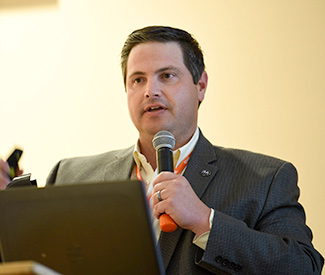Udder Score EPDs
Convenience traits add value and performance in the long run.
by Lindsay King, Angus Journal assistant editor
BROOKINGS, S.D. (June 19, 2019) — “The desire to go out in the pasture to look at a high-quality udder is something that all of us should have,” said Shane Bedwell, American Hereford Association COO and director of breed improvement, at the 2019 Beef Improvement Federation (BIF) research symposium in Brookings, S.D., June 18-21.
He added, “It’s tricky, because it is more of a convenience trait than an economic one.” That distinction can make it difficult to allocate finances toward the research of udder scores and a milk expected progeny difference (EPD).
Bedwell outlined reasons why it should be a priority for producers:
- labor associated with extra cost and reduced convenience,
- longevity, which may be reduced because of an injury or mastitis, and
- calf performance, by lower colostrum intake by newborn calves because of oversized teats.
“The Association began collecting these scores back in the early ’90s,” Bedwell said. “We had the ability to record and put those numbers into the database, but it wasn’t until 2015 that we launched the evaluation.”
In the early years, scores were given for overall udder quality, he explained. It was later split into two traits — udder and teats.

Shane Bedwell
Udder scoring is all about suspension, while teats are evaluated on their size, explained Shane Bedwell, COO and director of breed improvement for the American Hereford Association. Ease of access for the calf is the focus.
“It is evaluated on a repeated-measures model where we are getting observations on those females after each calving,” Bedwell said. “The recommended scoring is within 24 hours of calving. It goes on a birth and registration worksheet.”
Evaluated on a scale of 1 to 9, the larger numbers represent the better scores. Udder scoring is all about suspension, while teats are evaluated on their size. Ease of access for the calf is the focus.
Each score is put together to make a two-digit integer, Bedwell said. For example, if an udder scores a nine and a teat is also a nine, the total is a 99.
“The beauty of this EPD is that you can visibly see it working out in the pasture compared to what is being recorded,” Bedwell said. “The availability of that EPD is a testament to our breeders and what bull-selection decisions they have been making.”
On the American Hereford Association website, an EPD search engine is available. Bedwell said it is extensive, but the search allows producers of all breeds to find exactly what they are looking for in an animal.
“Because this is a convenience trait, these breeders are really setting the standard for what they will tolerate within their herds and then work off some of the other traits,” Bedwell said. “This allows our breeders to offer a more marketable product.”
The proof really is in the pudding, as Bedwell put it. Breeders will have the ability to quite literally check the boxes for their animals.
“This trait has a lot of room to change a lot of minds,” Bedwell added. “It is refreshing to see our breeders applying a very important trait to their selection process.”
The 2019 BIF Annual Convention was hosted by South Dakota State University and the South Dakota Beef Breeds Council June 18-21 at the University Comfort Suites and Convention Center in Bookings. ANGUS MEDIA® provides comprehensive online coverage of the event at www.BIFconference.com. Visit the Newsroom for summaries, proceedings, PowerPoints, video and/or audio of the sessions and the Awards page for announcements and photos of award winners.
Editor’s Note: This summary was written under contract or by staff of ANGUS MEDIA®. Through an agreement with the Beef Improvement Federation,
we encourage reprinting of the articles to those who will adhere to the
reprint guidelines available on this site. Please review those
guidelines or contact Shauna Rose Hermel,
editor, at 816-383-5270. PowerPoints are posted with permission of the
presenter and may not be reproduced in whole or in part without the
express permission of the presenter. We welcome educational venues and
cattlemen to link to this site as a service to their audience.
For questions about this site, or to notify us of broken links, click here. Look for additional coverage in the Angus Journal, the Angus Beef Bulletin, the Angus Journal Daily, the Angus Beef Bulletin EXTRA and Angus TV.


